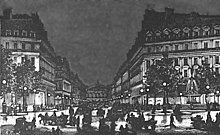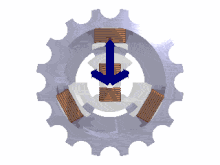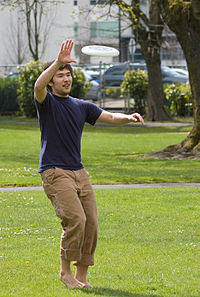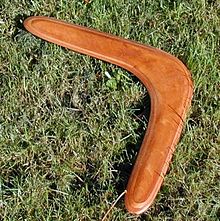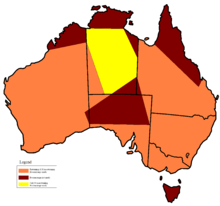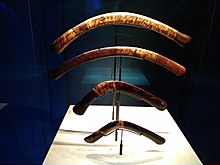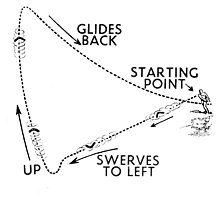Electrification is the process of powering by electricity and, in many contexts, the introduction of such power by changing over from an earlier power source. The broad meaning of the term, such as in the history of technology, economic history, and economic development, usually applies to a region or national economy. Broadly speaking, electrification was the build-out of the electricity generation and electric power distribution systems that occurred in Britain, the United States, and other now-developed countries from the mid-1880s until around 1950 and is still in progress in rural areas in some developing countries. This included the transition in manufacturing from line shaft and belt drive using steam engines and water power to electric motors.
The electrification of particular sectors of the economy is called by terms such as factory electrification, household electrification, rural electrification or railway electrification. It may also apply to changing industrial processes such as smelting, melting, separating or refining from coal or coke heating, or chemical processes to some type of electric process such as electric arc furnace, electric induction or resistance heating, or electrolysis or electrolytic separating.
Electrification was called "the greatest engineering achievement of the 20th Century" by the National Academy of Engineering.
History of electrification
The earliest commercial uses of electricity were electroplating and the telegraph.
Development of magnetos, dynamos and generators
Faraday disk, the first electric generator. The horseshoe-shaped magnet (A) created a magnetic field through the disk (D).
When the disk was turned, this induced an electric current radially
outward from the center toward the rim. The current flowed out through
the sliding spring contact m, through the external circuit, and back into the center of the disk through the axle.
In the years of 1831–1832, Michael Faraday discovered the operating principle of electromagnetic generators. The principle, later called Faraday's law, is that an electromotive force is generated in an electrical conductor that is subjected to a varying magnetic flux, as for example, a wire moving through a magnetic field. He also built the first electromagnetic generator, called the Faraday disk, a type of homopolar generator, using a copper disc rotating between the poles of a horseshoe magnet. It produced a small DC voltage.
Around 1832, Hippolyte Pixii
improved the magneto by using a wire wound horseshoe, with the extra
coils of conductor generating more current, but it was AC. André-Marie Ampère
suggested a means of converting current from Pixii's magneto to DC
using a rocking switch. Later segmented commutators were used to produce
direct current.
William Fothergill Cooke and Charles Wheatstone
developed a telegraph around 1838-40. In 1840 Wheatstone was using a
magneto that he developed to power the telegraph. Wheatstone and Cooke
made an important improvement in electrical generation by using a
battery-powered electromagnet in place of a permanent magnet, which they
patented in 1845. The self-excited magnetic field dynamo did away with the battery to
power electromagnets. This type of dynamo was made by several people in
1866.
The first practical generator, the Gramme machine was made by Z.T Gramme, who sold many of these machines in the 1870s. British engineer R. E. B. Crompton
improved the generator to allow better air cooling and made other
mechanical improvements. Compound winding, which gave more stable
voltage with load, improved operating characteristics of generators.
The improvements in electrical generation technology increased
the efficiency and reliability greatly in the 19th century. The first
magnetos only converted a few percent of mechanical energy to
electricity. By the end of the 19th century the highest efficiencies
were over 90%.
Electric lighting
Arc lighting
Yablochkov's demonstration of his brilliant arc lights at the 1878 Paris Exposition along the Avenue de l'Opéra triggered a steep sell off of gas utility stocks.
Sir Humphry Davy invented the carbon arc lamp in 1802 upon discovering that electricity could produce a light arc
with carbon electrodes. However, it was not used to any great extent
until a practical means of generating electricity was developed.
Carbon arc lamps were started by making contact between two
carbon electrodes, which were then separated to within a narrow gap.
Because the carbon burned away, the gap had to be constantly readjusted.
Several mechanisms were developed to regulate the arc. A common
approach was to feed a carbon electrode by gravity and maintain the gap
with a pair of electromagnets, one of which retracted the upper carbon
after the arc was started and the second controlled a brake on the
gravity feed.
Arc lamps of the time had very intense light output – in the range of 4000 candlepower (candelas) – and released a lot of heat, and they were a fire hazard, all of which made them inappropriate for lighting homes.
In the 1850s, many of these problems were solved by the arc lamp invented by William Petrie
and William Staite. The lamp used a magneto-electric generator and had a
self-regulating mechanism to control the gap between the two carbon
rods. Their light was used to light up the National Gallery
in London and was a great novelty at the time. These arc lamps and
designs similar to it, powered by large magnetos, were first installed
on English lighthouses in the mid 1850s, but the power limitations
prevented these models from being a proper success.
The first successful arc lamp was developed by Russian engineer Pavel Yablochkov, and used the Gramme generator.
Its advantage lay in the fact that it didn't require the use of a
mechanical regulator like its predecessors. It was first exhibited at
the Paris Exposition of 1878 and was heavily promoted by Gramme. The arc light was installed along the half mile length of Avenue de l'Opéra, Place du Theatre Francais and around the Place de l'Opéra in 1878.
British engineer R. E. B. Crompton
developed a more sophisticated design in 1878 which gave a much
brighter and steadier light than the Yablochkov candle. In 1878, he
formed Crompton & Co. and began to manufacture, sell and install the
Crompton lamp. His concern was one of the first electrical engineering
firms in the world.
Incandescent light bulbs
Various forms of incandescent light bulbs
had numerous inventors; however, the most successful early bulbs were
those that used a carbon filament sealed in a high vacuum. These were
invented by Joseph Swan in 1878 in Britain and by Thomas Edison
in 1879 in the US. Edison’s lamp was more successful than Swan’s
because Edison used a thinner filament, giving it higher resistance and
thus conducting much less current. Edison began commercial production of
carbon filament bulbs in 1880. Swan's light began commercial production
in 1881.
Swan's house, in Low Fell, Gateshead, was the world's first to have working light bulbs installed. The Lit & Phil Library in Newcastle, was the first public room lit by electric light, and the Savoy Theatre was the first public building in the world lit entirely by electricity.
Central power stations and isolated systems
The first central station providing public power is believed to be one at Godalming,
Surrey, U.K. autumn 1881. The system was proposed after the town failed
to reach an agreement on the rate charged by the gas company, so the
town council decided to use electricity. The system lit up arc lamps on
the main streets and incandescent lamps on a few side streets with
hydroelectric power. By 1882 between 8 and 10 households were connected,
with a total of 57 lights. The system was not a commercial success and
the town reverted to gas.
The first large scale central distribution supply plant was opened at Holborn Viaduct in London in 1882.
Equipped with 1000 incandescent lightbulbs that replaced the older gas
lighting, the station lit up Holborn Circus including the offices of the
General Post Office and the famous City Temple church. The supply was a direct current at 110 V; due to power loss in the copper wires, this amounted to 100 V for the customer.
Within weeks, a parliamentary committee recommended passage of
the landmark 1882 Electric Lighting Act, which allowed the licensing of
persons, companies or local authorities to supply electricity for any
public or private purposes.
The first large scale central power station in America was Edison's Pearl Street Station
in New York, which began operating in September 1882. The station had
six 200 horsepower Edison dynamos, each powered by a separate steam
engine. It was located in a business and commercial district and
supplied 110 volt direct current to 85 customers with 400 lamps. By 1884
Pearl Street was supplying 508 customers with 10,164 lamps.
By the mid-1880s, other electric companies were establishing central power stations and distributing electricity, including Crompton & Co. and the Swan Electric Light Company in the UK, Thomson-Houston Electric Company and Westinghouse in the US and Siemens in Germany. By 1890 there were 1000 central stations in operation. The 1902 census listed 3,620 central stations. By 1925 half of power was provided by central stations.
Load factor & isolated systems
One
of the biggest problems facing the early power companies was the hourly
variable demand. When lighting was practically the only use of
electricity, demand was high during the first hours before the workday
and the evening hours when demand peaked.
As a consequence, most early electric companies did not provide daytime
service, with two-thirds providing no daytime service in 1897.
The ratio of the average load to the peak load of a central station is called the load factor.
For electric companies to increase profitability and lower rates, it
was necessary to increase the load factor. The way this was eventually
accomplished was through motor load. Motors are used more during daytime and many run continuously.
Electric street railways were ideal for load balancing. Many electric
railways generated their own power and also sold power and operated
distribution systems.
The load factor adjusted upward by the turn of the 20th century—at Pearl Street
the load factor increased from 19.3% in 1884 to 29.4% in 1908. By 1929,
the load factor around the world was greater than 50%, mainly due to
motor load.
Before widespread power distribution from central stations, many
factories, large hotels, apartment and office buildings had their own
power generation. Often this was economically attractive because the
exhaust steam could be used for building and industrial process heat, which today is known as cogeneration
or combined heat and power (CHP). Most self-generated power became
uneconomical as power prices fell. As late as the early 20th century,
isolated power systems greatly outnumbered central stations. Cogeneration
is still commonly practiced in many industries that use large amounts
of both steam and power, such as pulp and paper, chemicals and refining.
The continued use of private electric generators is called microgeneration.
Direct current electric motors
The first commutator DC electric motor capable of turning machinery was invented by the British scientist William Sturgeon in 1832. The crucial advance that this represented over the motor demonstrated by Michael Faraday was the incorporation of a commutator. This allowed Sturgeon's motor to be the first capable of providing continuous rotary motion.
Frank J. Sprague improved on the DC motor
in 1884 by solving the problem of maintaining a constant speed with
varying load and reducing sparking from the brushes. Sprague sold his
motor through Edison Co.
It is easy to vary speed with DC motors, which made them suited for a
number of applications such as electric street railways, machine tools
and certain other industrial applications where speed control was
desirable.
Alternating current
Although the first power stations supplied direct current, the distribution of alternating current
soon became the most favored option. The main advantages of AC were
that it could be transformed to high voltage to reduce transmission
losses and that AC motors could easily run at constant speeds.
Alternating current technology was rooted in Michael Faraday's 1830–31 discovery that a changing magnetic field can induce an electric current in a circuit.
The first person to conceive of a rotating magnetic field was
Walter Baily who gave a workable demonstration of his battery-operated polyphase motor aided by a commutator on June 28, 1879 to the Physical Society of London. Nearly identical to Baily’s apparatus, French electrical engineer Marcel Deprez
in 1880 published a paper that identified the rotating magnetic field
principle and that of a two-phase AC system of currents to produce it. In 1886, English engineer Elihu Thomson built an AC motor by expanding upon the induction-repulsion principle and his wattmeter.
It was in the 1880s that the technology was commercially
developed for large scale electricity generation and transmission. In
1882 the British inventor and electrical engineer Sebastian de Ferranti, working for the company Siemens collaborated with the distinguished physicist Lord Kelvin to pioneer AC power technology including an early transformer.
A power transformer developed by Lucien Gaulard and John Dixon Gibbs was demonstrated in London in 1881, and attracted the interest of Westinghouse. They also exhibited the invention in Turin
in 1884, where it was adopted for an electric lighting system. Many of
their designs were adapted to the particular laws governing electrical
distribution in the UK.
Sebastian Ziani de Ferranti
went into this business in 1882 when he set up a shop in London
designing various electrical devices. Ferranti believed in the success
of alternating current power distribution early on, and was one of the
few experts in this system in the UK. With the help of Lord Kelvin, Ferranti pioneered the first AC power generator and transformer in 1882. John Hopkinson, a British physicist, invented the three-wire (three-phase) system for the distribution of electrical power, for which he was granted a patent in 1882.
The Italian inventor Galileo Ferraris invented a polyphase AC induction motor
in 1885. The idea was that two out-of-phase, but synchronized, currents
might be used to produce two magnetic fields that could be combined to
produce a rotating field without any need for switching or for moving
parts. Other inventors were the American engineers Charles S. Bradley
and Nikola Tesla, and the German technician Friedrich August Haselwander.
They were able to overcome the problem of starting up the AC motor by
using a rotating magnetic field produced by a poly-phase current. Mikhail Dolivo-Dobrovolsky
introduced the first three-phase induction motor in 1890, a much more
capable design that became the prototype used in Europe and the U.S. By 1895 GE and Westinghouse both had AC motors on the market.
With single phase current either a capacitor or coil (creating
inductance) can be used on part of the circuit inside the motor to
create a rotating magnetic field.
Multi-speed AC motors that have separately wired poles have long been
available, the most common being two speed. Speed of these motors is
changed by switching sets of poles on or off, which was done with a
special motor starter for larger motors, or a simple multiple speed
switch for fractional horsepower motors.
AC power stations
The first AC power station was built by the English electrical engineer Sebastian de Ferranti. In 1887 the London Electric Supply Corporation hired Ferranti for the design of their power station at Deptford.
He designed the building, the generating plant and the distribution
system. It was built at the Stowage, a site to the west of the mouth of Deptford Creek once used by the East India Company.
Built on an unprecedented scale and pioneering the use of high voltage
(10,000 V) AC current, it generated 800 kilowatts and supplied central
London. On its completion in 1891 it was the first truly modern power
station, supplying high-voltage AC power that was then "stepped down"
with transformers for consumer use on each street. This basic system
remains in use today around the world.
In America, George Westinghouse
who had become interested in the power transformer developed by Gaulard
and Gibbs, began to develop his AC lighting system, using a
transmission system with a 20:1 step up voltage with step-down. In 1890
Westinghouse and Stanley built a system to transmit power several miles
to a mine in Colorado. A decision was taken to use AC for power
transmission from the Niagara Power Project to Buffalo, New York.
Proposals submitted by vendors in 1890 included DC and compressed air
systems. A combination DC and compressed air system remained under
consideration until late in the schedule. Despite the protestations of
the Niagara commissioner William Thomson
(Lord Kelvin) the decision was taken to build an AC system, which had
been proposed by both Westinghouse and General Electric. In October 1893
Westinghouse was awarded the contract to provide the first three
5,000 hp, 250 rpm, 25 Hz, two phase generators. The hydro power plant went online in 1895, and it was the largest one until that date.
By the 1890s, single and poly-phase AC was undergoing rapid introduction. In the U.S. by 1902, 61% of generating capacity was AC, increasing to 95% in 1917.
Despite the superiority of alternating current for most applications, a
few existing DC systems continued to operate for several decades after
AC became the standard for new systems.
Three-phase rotating magnetic field of an AC motor.
The three poles are each connected to a separate wire. Each wire
carries current 120 degrees apart in phase. Arrows show the resulting
magnetic force vectors. Three phase current is used in commerce and
industry.
Steam turbines
The efficiency of steam prime movers in converting the heat energy of
fuel into mechanical work was a critical factor in the economic
operation of steam central generating stations. Early projects used
reciprocating steam engines, operating at relatively low speeds. The introduction of the steam turbine
fundamentally changed the economics of central station operations.
Steam turbines could be made in larger ratings than reciprocating
engines, and generally had higher efficiency. The speed of steam
turbines did not fluctuate cyclically during each revolution; making
parallel operation of AC generators feasible, and improved the stability
of rotary converters for production of direct current for traction and
industrial uses. Steam turbines ran at higher speed than reciprocating
engines, not being limited by the allowable speed of a piston in a
cylinder. This made them more compatible with AC generators with only
two or four poles; no gearbox or belted speed increaser was needed
between the engine and the generator. It was costly and ultimately
impossible to provide a belt-drive between a low-speed engine and a
high-speed generator in the very large ratings required for central
station service.
The modern steam turbine was invented in 1884 by the British Sir Charles Parsons, whose first model was connected to a dynamo that generated 7.5 kW (10 hp) of electricity. The invention of Parson's steam turbine made cheap and plentiful electricity possible. Parsons turbines
were widely introduced in English central stations by 1894; the first
electric supply company in the world to generate electricity using turbo generators was Parsons' own electricity supply company Newcastle and District Electric Lighting Company, set up in 1894. Within Parson's lifetime, the generating capacity of a unit was scaled up by about 10,000 times.
An 1899 Parsons steam turbine linked directly to a dynamo
The first U.S. turbines were two De Leval units at Edison Co. in New York in 1895. The first U.S. Parsons turbine was at Westinghouse Air Brake Co. near Pittsburgh.
Steam turbines also had capital cost and operating advantages
over reciprocating engines. The condensate from steam engines was
contaminated with oil and could not be reused, while condensate from a
turbine is clean and typically reused. Steam turbines were a fraction
of the size and weight of comparably rated reciprocating steam engine.
Steam turbines can operate for years with almost no wear. Reciprocating
steam engines required high maintenance. Steam turbines can be
manufactured with capacities far larger than any steam engines ever
made, giving important economies of scale.
Steam turbines could be built to operate on higher pressure and temperature steam. A fundamental principle of thermodynamics
is that the higher the temperature of the steam entering an engine, the
higher the efficiency. The introduction of steam turbines motivated a
series of improvements in temperatures and pressures. The resulting
increased conversion efficiency lowered electricity prices.
The power density of boilers was increased by using forced
combustion air and by using compressed air to feed pulverized coal.
Also, coal handling was mechanized and automated.
Electrical grid
With the realization of long distance power transmission it was
possible to interconnect different central stations to balance loads and
improve load factors. Interconnection became increasingly desirable as
electrification grew rapidly in the early years of the 20th century.
Charles Merz, of the Merz & McLellan consulting partnership, built the Neptune Bank Power Station near Newcastle upon Tyne in 1901, and by 1912 had developed into the largest integrated power system in Europe.
In 1905 he tried to influence Parliament to unify the variety of
voltages and frequencies in the country's electricity supply industry,
but it was not until World War I
that Parliament began to take this idea seriously, appointing him head
of a Parliamentary Committee to address the problem. In 1916 Merz
pointed out that the UK could use its small size to its advantage, by
creating a dense distribution grid to feed its industries efficiently.
His findings led to the Williamson Report
of 1918, which in turn created the Electricity Supply Bill of 1919. The
bill was the first step towards an integrated electricity system in the
UK.
The more significant Electricity (Supply) Act of 1926, led to the setting up of the National Grid. The Central Electricity Board standardised the nation's electricity supply and established the first synchronised AC grid, running at 132 kilovolts and 50 Hertz. This started operating as a national system, the National Grid, in 1938.
In the United States it became a national objective after the
power crisis during the summer of 1918 in the midst of World War I to
consolidate supply. In 1934 the Public Utility Holding Company Act recognized electric utilities as public goods
of importance along with gas, water, and telephone companies and
thereby were given outlined restrictions and regulatory oversight of
their operations.
Household electrification
The
electrification of households in Europe and North America began in the
early 20th century in major cities and in areas served by electric
railways and increased rapidly until about 1930 when 70% of households
were electrified in the U.S.
Rural areas were electrified first in Europe, and in the US the Rural Electric Administration, established in 1935 brought electrification to rural areas.
Historical cost of electricity
Central
station electric power generating provided power more efficiently and
at lower cost than small generators. The capital and operating cost per
unit of power were also cheaper with central stations. The cost of electricity fell dramatically in the first decades of the twentieth century due to the introduction of steam turbines
and the improved load factor after the introduction of AC motors. As
electricity prices fell, usage increased dramatically and central
stations were scaled up to enormous sizes, creating significant
economies of scale. For the historical cost see Ayres-Warr (2002) Fig. 7.
Benefits of electrification
Benefits of electric lighting
Electric
lighting was highly desirable. The light was much brighter than oil or
gas lamps, and there was no soot. Although early electricity was very
expensive compared to today, it was far cheaper and more convenient than
oil or gas lighting. Electric lighting was so much safer than oil or
gas that some companies were able to pay for the electricity with the
insurance savings.
Pre-electric power
"One of the inventions most important to a class of highly skilled workers (engineers) would be a small motive power - ranging perhaps from the force of from half a man to that of two horses, which might commence as well as cease its action at a moment's notice, require no expense of time for its management and be of modest cost both in original cost and in daily expense." Charles Babbage, 1851
To be efficient steam engines needed to be several hundred horsepower.
Steam engines and boilers also required operators and maintenance. For
these reasons the smallest commercial steam engines were about 2
horsepower. This was above the need for many small shops. Also, a small
steam engine and boiler cost about $7,000 while an old blind horse that
could develop 1/2 horsepower cost $20 or less. Machinery to use horses for power cost $300 or less.
Threshing machine in 1881.
Many power requirements were less than that of a horse. Shop
machines, such as woodworking lathes, were often powered with a one- or
two-man crank. Household sewing machines were powered with a foot
treadle; however, factory sewing machines were steam-powered from a line shaft. Dogs were sometimes used on machines such as a treadmill, which could be adapted to churn butter.
In the late 19th century specially designed power buildings leased space to small shops. These building supplied power to the tenants from a steam engine through line shafts.
Electric motors were several times more efficient than small
steam engines because central station generation was more efficient than
small steam engines and because line shafts and belts had high friction
losses.
Electric motors were more efficient than human or animal power.
The conversion efficiency for animal feed to work is between 4 and 5%
compared to over 30% for electricity generated using coal.
Economic impact of electrification
Electrification and economic growth are highly correlated. In economics, the efficiency of electrical generation has been shown to correlate with technological progress.
In the U.S. from 1870-80 each man-hour was provided with .55 hp.
In 1950 each man-hour was provided with 5 hp, or a 2.8% annual
increase, declining to 1.5% from 1930-50. The period of electrification of factories and households from 1900 to 1940, was one of high productivity and economic growth.
Most studies of electrification and electric grids focused on
industrial core countries in Europe and the United States. Elsewhere,
wired electricity was often carried on and through the circuits of
colonial rule. Some historians and sociologists considered the interplay
of colonial politics and the development of electric grids: in India,
Rao
showed that linguistics-based regional politics — not
techno-geographical considerations — led to the creation of two separate
grids; in colonial Zimbabwe (Rhodesia), Chikowero
showed that electrification was racially based and served the white
settler community while excluding Africans; and in Mandate Palestine,
Shamir claimed that British electric concessions to a Zionist-owned company deepened the economic disparities between Arabs and Jews.
Power sources for generation of electricity
[DJS -- Nuclear power not mentioned. Bias?]
Most electricity is generated by thermal power stations or steam plants, the majority of which are fossil fuel power stations that burn coal, natural gas, fuel oil or bio-fuels, such as wood waste and black liquor from chemical pulping.
The most efficient thermal system is combined cycle in which a combustion turbine
powers a generator using the high temperature combustion gases and then
exhausts the cooler combustion gases to generate low pressure steam for
conventional steam cycle generation.
Hydroelectricity
Hydroelectricity uses a water turbine to generate power. In 1878 the world's first hydroelectric power scheme was developed at Cragside in Northumberland, England by William George Armstrong. It was used to power a single arc lamp in his art gallery. The old Schoelkopf Power Station No. 1 near Niagara Falls in the U.S. side began to produce electricity in 1881. The first Edison hydroelectric power plant, the Vulcan Street Plant, began operating September 30, 1882, in Appleton, Wisconsin, with an output of about 12.5 kilowatts.
Wind turbines
The first electricity-generating wind turbine was a battery charging machine installed in July 1887 by Scottish academic James Blyth to light his holiday home in Marykirk, Scotland. Some months later American inventor Charles F Brush built the first automatically operated wind turbine for electricity production in Cleveland, Ohio.
Advances in recent decades greatly lowered the cost of wind power making
it one of the most competitive alternate energies and competitive with
higher priced natural gas (before shale gas). Wind energy's main problem
is that it is intermittent and therefore needs grid extensions and
energy storage to be a reliable main energy source.
Geothermal energy
Prince Piero Ginori Conti tested the first geothermal power generator on 4 July 1904 in Larderello, Italy. It successfully lit four light bulbs.
Later, in 1911, the world's first commercial geothermal power plant was
built there. Italy was the world's only industrial producer of
geothermal electricity until 1958.
Geothermal requires very hot underground temperatures near the surface
to generate steam which is used in a low temperature steam plant.
Geothermal power is only used in a few areas. Italy supplies all of the
electrified rail network with geothermal power.
Solar energy
Electricity production from solar energy either directly through photovoltaic cells or indirectly such as by producing steam to drive a steam turbine generator.
Current extent of electrification
World map showing the percentage of the population in each country with access to mains electricity, as of 2017.
80.1%–100%
60.1%–80%
40.1%–60%
20.1%–40%
0–20%
While electrification of cities and homes has existed since the late
19th century, about 840 million people (mostly in Africa) had no access
to grid electricity in 2017, down from 1.2 billion in 2010.
Most recent progress in electrification took place between the
1950s and 1980s. Vast gains were seen in the 1970s and 1980s - from 49
percent of the world's population in 1970 to 76 percent in 1990. Recent gains have been more modest - by the early 2010s 81 to 83 percent of the world's population had access to electricity.
Energy resilience
Electricity is a "sticky" form of energy, in that it tends to stay in
the continent or island where it is produced. It is also multi-sourced;
if one source suffers a shortage, electricity can be produced from
other sources, including renewable sources. As a result, in the long term it is a relatively resilient means of energy transmission.
In the short term, because electricity must be supplied at the same
moment it is consumed, it is somewhat unstable, compared to fuels that
can be delivered and stored on-site. However, that can be mitigated by grid energy storage and distributed generation.

